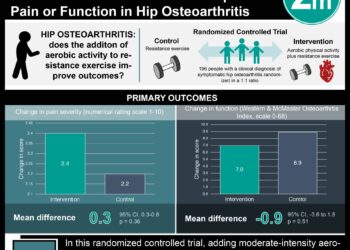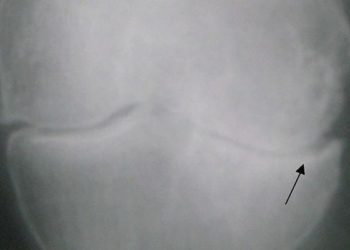Lower body mass index and higher physical function prior to total knee arthroplasty associated with improved function postoperatively
1. Higher presurgical body mass index was associated with poor function after total knee arthroplasty.
2. High physical function and osteoarthritis severity preoperatively were associated with improved function after total knee arthroplasty.
Level of Evidence Rating: 1 (Excellent)
Study Rundown: Total knee arthroplasty (TKA) is one of the most common surgical procedures performed in Western countries. This procedure is the standard of care for patients with end-stage osteoarthritis of the knee and continues to play a significant role in the surgical landscape given the needs of the aging population. Unfortunately, 20% of patients do not regain satisfactory knee function following this operation. This study sought to describe factors which facilitate and hinder functional recovery following TKA.
A total of 20 studies including 11,317 patients were included and 37 factors in total were identified as potential predictors of postoperative functional recovery at 12 months. The most commonly studied factors included preoperative function, mental health, psychological distress and age. Higher preoperative body mass index (BMI) was found to negatively correlate with improved physical function following TKA. Good preoperative physical function and osteoarthritis severity were both found to correlate with improved physical function postoperatively. Mental health was not significantly associated with postoperative function.
The present study by Olsen et al identified several factors which were positively, and negatively correlated with improved functional recovery 1 year following TKA. This information is helpful in prognosticating how patients will fare postoperatively and identify patients who may derive the greatest benefit from the operation. Strengths of this study include the quality of evidence owing to the systematic review & meta-analysis study design. A primary limitation of this study was the high degree of heterogeneity and the high risk of bias identified amongst several of the studies. Future study of prognostic factors in TKA functional improvement should focus on the clinical applications of the findings described in this study.
Click here to read this study in JAMA Orthopedics
Relevant reading: Neighbours-based prediction of function after total knee arthroplasty
In Depth [systematic review and meta-analysis]: The protocol for this systematic review and meta-analysis was published a priori. Five databases were searched for eligible studies published between January 1, 2000 and October 8, 2021. Prospective studies of adult patients with osteoarthritis undergoing TKA were eligible for inclusion. The primary outcome was physical function at 12 months after surgery. Risk of bias was assessed using the Quality in Prognosis Studies (QUIPS) tools and the quality of evidence was assessed using the GRADE tool to summarize evidence.
The mean correlation for improved physical function and higher preoperative BMI was -0.15 (95% confidence interval -0.24 to -0.05); there was moderate heterogeneity amongst the studies assessing this factor as evidenced by an I2 score of 46%. The correlation between good physical function preoperatively and postoperative functional improvement was 0.14 (0.02 to 0.26); there was substantial heterogeneity amongst the studies yielding this estimate (I2 of 90%). Mental health was not significantly correlated with postoperative improvement (0.12, 95% confidence interval -0.01 to 0.25). Finally, higher severity of osteoarthritis was also positively correlated with improved recovery with a correlation coefficient of 0.1 (0.01 to 0.19). Other factors which were significantly associated with improved functional recovery postoperatively included mobility (0.25, 0.05 to 0.44), Kellgren-Lawrence grade (0.1, 0.01 to 0.19), symptomatic joints (-0.2, -0.35 to -0.03); however, each of these were assessed in 2 or fewer studies within this analysis.
Image: PD
©2022 2 Minute Medicine, Inc. All rights reserved. No works may be reproduced without expressed written consent from 2 Minute Medicine, Inc. Inquire about licensing here. No article should be construed as medical advice and is not intended as such by the authors or by 2 Minute Medicine, Inc.







